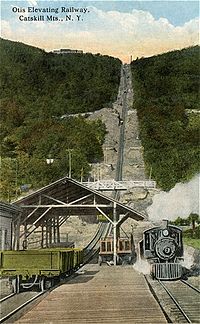- Otis Elevating Railway
-
The Otis Elevating Railway was a cable funicular railroad to the Catskill Mountain House in Palenville, New York. For the first 64 years of its existence, the Catskill Mountain House was accessible only by a long stage coach from Catskill Landing on the Hudson. Faced with increased competition from the Hotel Kaaterskill, served by the Kaaterskill Railroad, Charles Beach hired the Otis Elevator Company to build a cable funicular railroad straight up the Wall Of The Manitou. Opening on August 7, 1892, the line was 7,000' long with a rise of 1,630', a maximum grade of 34%, and an average grade of 12%. In 1904, the line was shortened and the lower trestle eliminated.
A cable pulled the specially-designed passenger cars up the mountain, with the car having a mechanism that hooked onto the cable. To balance the system there were two cars. The cars were built by Jackson & Sharp Co. in 1892, and each car could seat 75 passengers. The cars were named Rickerson and Van Santvoord. A small open-air baggage car was coupled to the downhill end of each passenger car.
The cable was pulled by two Hamilton Corliss steam engines that spun a set of cogwheels that drove the cable. Each engine was 12 inches in diameter and had a 30-inch stroke. Steam was supplied by two Manning Patent vertical tubular boilers. As one car went up from the bottom of the incline, the other car went down from the top of the incline. There was a passing track in the middle of the run where the track split in two, and then rejoined. This was so the cars could pass each other without colliding, as they shared the center rail above and below the passing track.
The Otis Railway and the Catskill Mountain Railway had several freight cars interchangeable with both the Catskill and Tannersville Railway at Summit Station and the Catskill Mountain Railway at Junction Station. The freight cars were 22 feet long and had a capacity of 5 tons or 8 tons.[1] One car could be carried at a time coupled below the coach. Boxcars were Otis Ry. 1, Otis Ry. 2, C.M. Ry. 17 & C.M. Ry. 18. Gondolas were Otis Ry. 3, Otis Ry. 4, C.M. Ry. 15 & C.M. Ry. 16. [2][3] In operation, a single freight car could be coupled to the downhill end of the open-air baggage car.
The Otis Junction station (pictured right after the 1904 reconstruction) connected the Otis to the Catskill Mountain Railway, a 15 mile railroad between Catskill Landing and Palenville, New York. At the Otis Summit station at the top, it connected to the Catskill and Tannersville Railway, that ran the 5.2 miles to Tannersville. In 1918, all three railroads were closed and sold for scrap. The two cars survive to this day. Soon after the railroad was scrapped, the coaches were shipped to Lookout Mountain, where they now serve the Lookout Mountain Incline Railway.
Stations
- Otis Junction Station
- Otis Summit Station
References
- Helmer, William F. (1970). Rip Van Winkle Railroads. Howell-North Books. ISBN 0-8310-7079-X.
- ^ The Helmer (1970) reference states "5 tons" at page 83, and states "8 tons" at page 137.
- ^ Annual Report of the Board of Railroad Commissioners of the State of New York. New York State Legislature., various dates.
- ^ Poor, Henry V. and Henry W. Poor (various years). Poor’s Manual of Railroads. H.V. and H.W. Poor Co., various dates.
External links
Categories:- Otis Elevator Company
- Defunct New York railroads
- Catskills
- Transportation in Greene County, New York
- 3ft gauge railways
- Narrow gauge railroads in New York
- Defunct funicular railways in the United States
Wikimedia Foundation. 2010.

